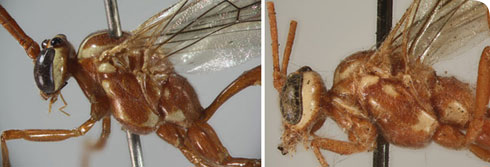Taxonomy
Most species of Ophion are very difficult to identify but O. obscuratus is one of the more conspicuous species.
In northern Europe at least, O. obscuratus is usually readily recognisable as it is the only frequently encountered species which has copious yellow or creamy markings.
However, there are 2 pitfalls:
- Similar appearance of Ophion forticornis
- Dwarf forms of O. obscuratus that can superficially resemble other Ophion species
Distinguishing O. forticornis from O. obscuratus
O. forticornis:
- is rarely collected in Britain (but is seemingly more frequent in some other countries)
- is restricted to sand dunes
- has a much greater gap between the ocelli and eyes
- has a rather slenderer metasoma (abdomen)

Left: The deeper metasoma of Ophion obscuratus (anterior to left). Right: The slenderer metasoma of Ophion forticornis (anterior to left).
Dwarf forms of O. obscuratus
O. obscuratus is known to occur in 3 distinct morphs in Britain (Brock, 1982):
- spring form
- 'autumnal dwarfs'
- 'autumnal giants' – the most frequent form
Whether they really belong to the same species is not certain.
The spring and dwarf forms have been reared from a variety of low-feeding moth larvae of the family Noctuidae, such as Mythimna and Lycophotia. The autumn (and winter) flying giants, have never been reared. The host must almost certainly be a very common, yet hardly reared noctuid larva.
Dwarf forms of O. obscuratus that lack the yellow markings superficially resemble other Ophion species, such as:
- O. crassicornis
- O. parvulus
However, they can still be recognised as O. obscuratus by the:
- yellow apex to the stigma
- the noticeably paler stripes along the inner edges of the eyes
Ichneumonidae
Ophion obscuratus is just one of over 2,300 British species of Ichneumonidae. A checklist of the British and Irish species is available:
Checklist of British and Irish Ichneumonidae (Hymenoptera) PDF (1.1 MB)
